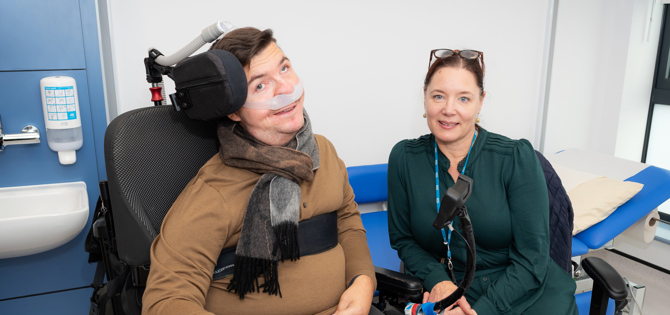RJAH pioneers new model of palliative care that is set to go global
Posted: 8 Oct 2025

A pioneering model of palliative care developed at The Robert Jones and Agnes Hunt Orthopaedic Hospital (RJAH) is to be showcased to an international audience.
The Oswestry Model is an approach developed to support adults with neuromuscular conditions such as Duchenne Muscular Dystrophy (DMD).
DMD causes progressive muscle weakness and wasting, mainly affecting boys. It starts in early childhood, eventually leading to a loss of mobility. Life span for someone with DMD is unpredictable but is typically around 28 years.
The Oswestry Model uses a traffic light system to help neuromuscular teams identify key stages in a patient’s journey in which hospice involvement would improve their quality of life.
Originally developed in partnership with Severn Hospice in Shropshire, the model has now been widely adopted across the UK. And the teams behind its creation now hope it can be recognised globally as well. It will be formally presented at the World Muscle Society’s annual conference in Vienna this week.
Professor Tracey Willis, a Consultant Paediatric Neurologist with a Specialty Interest in Neuromuscular Disorders at Oswestry-based RJAH, leads the team that has created the model. It adopts a traffic light system to identify triggers in a patient’s palliative care needs.
“We didn’t think this was anything ground-breaking when we started it eight years or so ago,” said Prof Willis. “We just thought it was logical, but no-one else seemed to be doing it.
“Neuromuscular conditions like Duchenne Muscular Dystrophy can be very unpredictable so it is not as straight-forward to put palliative measures in place as it is for a condition such as cancer. We felt strongly that our patients should be entitled to have these discussions and to have their say in what they would like to happen.
“We devised a traffic light system and it helped us to go through our cohort of patients and identify them as green, amber or red,” she added.
“If they are amber, it signposts that they should be having these discussions. When they tip over into red, they should be seen in a symptom control clinic and be seen by a Palliative Care Consultant.”
The Oswestry Model was worked up by Prof Willis’s team, with symptom control clinics delivered at Severn Hospice, where her husband, Prof Derek Willis, is Medical Director.
“Our being husband and wife has probably helped this to develop, as we have naturally had conversations and a shared willingness and enthusiasm to take this forward,” she said.
“We’ve seen the model develop into a hub and spoke over the last eight years, with patients in other areas outside of our catchment benefitting as well.
“This year we are working with three other centres in London, Manchester and Sheffield and helping them to look at particular groups of patients and use the Oswestry Model.
“Now we have the chance to take the learning and the knowledge and share it with an international audience, so I hope we could start to see the Oswestry Model being adopted further afield as well.”